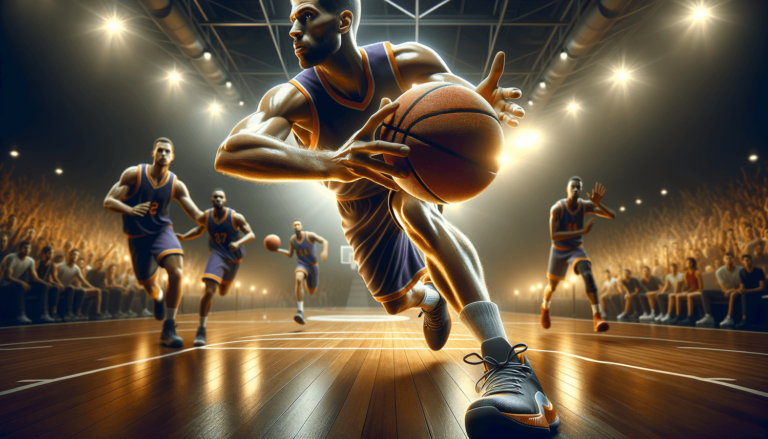
Welcome to the exciting world of basketball passing! Passing is an essential skill that can elevate your game to new heights and make you an invaluable asset to your team. In this blog post, we will delve into everything you need to know to improve your basketball passing skills, from mastering the basics to practicing advanced techniques. So whether you’re a rookie looking for tips or a seasoned player aiming to refine your craft, you’ve come to the right place. Let’s dive in and take your passing game to the next level!
How to Improve Your Basketball Passing Skills?
To improve your basketball passing skills, focus on mastering the fundamentals, such as grip, accuracy, and timing. Practice various types of passes like the chest, bounce, and overhead pass. Strengthen your non-dominant hand to become more versatile, and develop court vision by consistently scanning the court and anticipating teammates’ movements. Incorporate drills that simulate game situations and challenge yourself by practicing passes under defensive pressure. Lastly, don’t be afraid to analyze and learn from both your successes and mistakes on the court.
Mastering the Fundamentals of Passing
An essential step to improving your basketball passing skills is to master the fundamentals. This includes perfecting your grip on the ball, enhancing your accuracy, and fine-tuning your timing. These basic techniques lay the foundation for success in all aspects of the game, ensuring that you’ll be well-equipped to make effective passes on the court.
Grip and Ball Handling
A good grip is crucial for effective passing. Start by positioning your hands on either side of the ball, with your fingers spread and your palms facing each other. This will provide you with maximum control and allow for more precise passes. Additionally, work on your dribbling skills to build confidence in handling the ball under pressure. Mastering ball handling will translate to increased efficiency and effectiveness in your ability to deliver passes.
Accuracy and Precision
Accuracy is essential for successful passing. Focus on the target you wish to send the ball to, and aim for precision. Spend time practicing passes at varying distances and angles, gaining muscle memory that will ultimately give you a higher level of control when executing passes during games. Keeping your eyes on the target and following through with your hands will increase the chances of getting the ball precisely where you want it to go.
Timing and Anticipation
Perfecting timing is vital in basketball. A well-timed pass can significantly impact the game’s flow and increase the chances of scoring. Develop a sense of anticipation by recognizing when your teammates are open and ready to receive a pass. Good communication skills and an understanding of your teammates’ habits will help you anticipate their movements and make better passes.
Understanding and Practicing Various Pass Types
There are a variety of passes you can use during a basketball game to ensure your team remains unpredictable and difficult to defend. Becoming proficient in different pass types will make you a more versatile and valuable player on the court. Here’s a look at some of the most common pass types and how to practice them.
Chest Pass
The chest pass is a fundamental basketball pass where the ball is thrown directly from the passer’s chest to the receiver’s chest. To practice this pass, grip the ball with both hands, step towards your target, and push the ball off your chest in a straight line. Aim for speed and accuracy to make it difficult for defenders to intercept the pass.
Bounce Pass
A bounce pass is a useful tool for passing the ball under the defense. In this pass, the ball is thrown towards the ground, causing it to bounce up to the receiver. To practice this technique, aim for a spot on the floor about two-thirds of the distance to your target. As you throw the ball, create backspin by flicking your wrists – this will help control the bounce and make it easier for your teammate to catch.
Overhead Pass
An overhead pass is often used to throw the ball over multiple defenders or pass it from one side of the court to the other. To execute this pass, bring the ball above your head with both hands and snap your wrists as you release the ball. Focus on generating power and accuracy to make it an effective pass.
No-Look Pass
The no-look pass is a deceptive move where the passer looks in one direction while passing the ball in another. This can be a great way to fake out defenders and create scoring opportunities. To practice this pass, start by looking at one teammate before quickly passing to another. As you become more comfortable, incorporate no-look passes into your regular passing drills to develop this skill further.
Developing a Strong Non-Dominant Hand
Becoming ambidextrous on the court is a valuable skill that will make you a more versatile and challenging player to defend. A strong non-dominant hand enables you to pass the ball with either hand, creating more opportunities and making it difficult for defenders to predict your moves. Spend time working on dribbling, passing, and shooting with your non-dominant hand to enhance your overall basketball skills.
Cultivating Court Vision and Awareness
Good court vision allows you to make smart decisions and find open teammates to pass the ball. Consistently practicing court awareness will help you develop the ability to see and anticipate your teammates’ movements, as well as identify and exploit gaps in the defense.
Scanning the Court
Get into the habit of continuously scanning the court, keeping an eye on both your teammates and the opposing team’s movements. This will help you make informed decisions about when and where to pass the ball, as well as recognize potential scoring opportunities.
Anticipating Your Teammates’ Movements
Understanding your teammates’ habits and preferences, as well as their position on the court, is key to anticipating their movements. Observe your teammates during practices and games, taking note of their preferences and tendencies. Communicate with them both on and off the court to develop a strong understanding of each other’s play styles.
Incorporating Passing Drills into Your Training Sessions
Developing and refining your passing skills requires consistent practice. Incorporate various passing drills into your training sessions to improve your technique, accuracy, and decision-making abilities. Here are a few drill suggestions you can use to elevate your passing game:
Three-Man Weave
This classic drill involves three players weaving in and out as they pass the ball down the court. The goal is to move the ball quickly and efficiently, while also focusing on passing accuracy and speed. The three-man weave is a great way to practice a variety of passes, including the chest pass, bounce pass, and no-look pass.
Partner Passing
Find a teammate or friend to practice your passing skills with. Stand facing each other and take turns passing the ball using different techniques. You can incorporate variations like passing while on the move or adding a defender to simulate game situations. Make sure to focus on accuracy, speed, and maintaining proper mechanics during the whole process.
Star Passing Drill
The star passing drill involves five players standing in a star formation, with one player in the center. The player in the center receives passes from each of the outer players, then returns the pass before rotating to the next outer player. This drill helps develop passing accuracy under pressure, as the center player must quickly execute successive passes.
Practicing Passes under Defensive Pressure
Great passers are able to perform well under pressure. To become proficient in passing while being closely defended, incorporate defensive pressure into your practice sessions. Play one-on-one or scrimmage games to simulate real-game situations, focusing on maintaining composure and executing precise passes even when being guarded closely by a defender. This can also help build your confidence in executing passes during high-pressure and fast-paced games.
Learning from Your Successes and Mistakes
Improvement often comes from analyzing and learning from both your successes and mistakes in basketball. Watch recorded games or attend live games to study the passing skills of both professional players and your peers. Take note of what works and what doesn’t, and strive to incorporate those lessons into your own gameplay. Don’t be afraid to seek feedback from your coaches and teammates; they can be valuable resources in helping you identify areas for growth and improvement as you work to become a better passer.
Putting It All Together
Improving your basketball passing skills is no small feat. Dedication, practice, and a strong understanding of the game are all critical components of success. By focusing on the fundamentals, practicing various pass types, developing court awareness, incorporating passing drills into your training sessions, and learning from your experiences, you’ll be well on your way to becoming an exceptional passer who makes a significant impact on the court.
Emphasizing Communication and Teamwork
Effective passing in basketball goes beyond just technical skills. Communication and teamwork play a significant role in the success of a team’s passing game. Developing strong communication skills and fostering a positive team environment not only improves your personal passing abilities but also enhances the performance of the entire team.
Non-Verbal Communication
Non-verbal communication on the court is crucial. Frequently, players communicate through signals and body language, such as pointing or nodding in a particular direction. Learn to recognize and understand these cues to better anticipate your teammates’ movements and intentions. This will enable you to make more accurate and timely passes during games.
Verbal Communication
While non-verbal communication is important, being vocal and communicating verbally with your teammates can enhance your passing game. Call out plays, inform teammates of their positions, or alert them when you’re ready to make a pass. This ongoing dialogue fosters trust among team members and often leads to more accurate and efficient passing on the court.
Team Chemistry
Team chemistry is an intangible aspect of the game that has a significant impact on your ability to make successful passes. Build friendship and camaraderie among your teammates to create an environment in which players understand one another’s strengths and weaknesses. Bonding activities off the court can greatly contribute to a more effective passing game and a stronger, more cohesive team on the court.
Focusing on Conditioning and Agility
A well-rounded basketball player requires more than just technical skills; physical conditioning and agility play a key role in your overall performance, particularly when it comes to making effective passes. Incorporate physical training into your regimen to see improvements in your passing and overall basketball skills.
Strength Training
Strong arms, core, and legs all contribute to the power and accuracy of your passes. Incorporate strength training exercises into your fitness routine to build muscle and boost your physical performance. Remember to consult with a coach or fitness professional to ensure that your strength training program is safe and effective, tailored to your specific needs and goals.
Agility Training
Agility is critical in basketball, allowing you to move quickly and easily around the court, evade defenders, and make accurate passes in high-pressure situations. Implement speed and agility exercises, such as ladder drills, cone exercises, and shuttle runs, to enhance your reaction time, balance, and coordination on the court.
Endurance Training
Effectively performing passes throughout an entire game requires stamina and endurance. Integrate cardiovascular exercises, such as running, cycling, or swimming, into your routine to maintain a high level of energy and performance from the beginning of the game to the final buzzer.
Continuing Your Basketball Education
Stay informed about new strategies, techniques, and training methods that emerge within the world of basketball. The game continually evolves, making it essential for players to learn and adapt their skills. Be proactive in seeking knowledge, attending workshops or clinics, watching instructional videos, and reading up on basketball articles or books. A hunger for learning and self-improvement will not only help you become a better passer but also an overall more proficient basketball player.
Frequently Asked Questions
Here are answers to some common questions you might have about improving your basketball passing skills. This FAQ section addresses various aspects of passing, including technique, strategies, and tips for reaching your full potential on the court.
1. How can I improve my passing accuracy?
To improve passing accuracy, focus on the fundamentals, such as grip, hand positioning, and following through with your passes. Make sure to keep your eyes on the target and practice various passes at different distances and angles to develop muscle memory.
2. How can I become a better passer under defensive pressure?
Practice passing while being guarded closely by a defender to improve your ability to perform well under pressure. Incorporate one-on-one or scrimmage games in your practice sessions to simulate real-game situations and develop your confidence in passing under pressure.
3. How can I develop better court vision and awareness?
Develop better court vision by consistently scanning the court, keeping an eye on both your teammates and the opposing team’s movements. Understand your teammates’ habits and preferences, communicate effectively, and maintain positional awareness to anticipate their movements and make better passes.
4. How can I improve my no-look pass technique?
Start by practicing looking at one teammate before quickly passing to another to improve your no-look pass technique. Focus on executing accurate passes without giving away your intentions through eye contact or body language. As you become more comfortable, incorporate no-look passes into your regular passing drills for further refinement.
5. How can I strengthen my non-dominant hand for passing?
Work on dribbling, passing, and shooting with your non-dominant hand to enhance your overall basketball skills. Consistent practice and repetition will help build muscle memory and develop your ambidextrous passing abilities.
6. What are the main types of basketball passes?
Some common basketball pass types include chest pass, bounce pass, overhead pass, and no-look pass. Mastering these different passing techniques will aid in your versatility and unpredictability on the court, making it harder for defenders to anticipate your moves.
7. What exercises can help improve my passing game?
Consider incorporating drills such as the three-man weave, partner passing, and star passing into your training sessions. Practicing different types of passes, working on accuracy and timing, and applying defensive pressure will help you develop and refine your passing skills.
8. How can I improve my passing decision-making?
To improve your passing decision-making, focus on developing your court vision and anticipating your teammates’ movements. Additional factors include understanding the game situation, knowing each teammate’s strengths and weaknesses, and being aware of the position of defenders.
9. How important is communication in basketball passing?
Effective communication is crucial in basketball passing. Both verbal and non-verbal communication help players understand each other’s intentions, resulting in successful and efficient passing. Enhance your communication skills to improve teamwork and the overall performance of your team’s passing game.
10. How much time should I dedicate to practicing my passing skills?
Dedicate consistent and regular practice sessions to improve your passing skills. Include passing drills to work on technique, accuracy, and situational decision-making. The more time and effort you dedicate to practice, the more significant the improvement in your passing game will be.
Featured Posts
- No pillar pages found.





